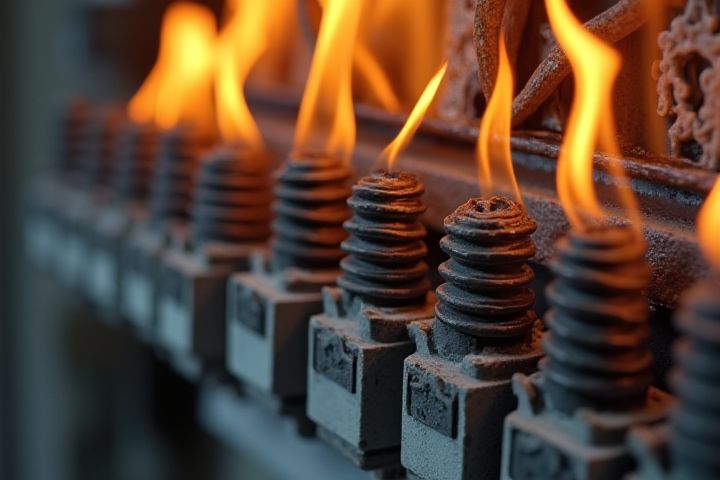
Faulty house wiring can indeed be a significant fire hazard. Overloaded circuits, damaged insulation, and outdated wiring systems increase the risk of electrical fires. Signs of potential wiring issues include frequent circuit breaker trips, flickering lights, or burning smells. Regular inspections and necessary upgrades to your electrical system can help mitigate these dangers. Ensuring proper grounding and circuit protection devices, like GFCIs and AFCIs, is essential for keeping your home safe from electrical fires.
Can House Wiring Cause A Fire
Faulty electrical connections
Faulty electrical connections are a leading cause of house fires, accounting for approximately 30% of electrical fires reported annually. Poorly secured wires can create excessive heat, potentially igniting nearby flammable materials. In homes older than 20 years, the risk increases due to outdated wiring practices that often fail to meet current safety standards. Regular inspections can help detect and remedy these hazardous connections, ensuring your household remains safe from fire risks.
Overloading circuits
Overloading circuits is a primary cause of electrical fires in homes, responsible for approximately 30% of such incidents. When multiple high-wattage appliances are connected to a single circuit, the demand for electricity can exceed the circuit's capacity, often rated at 15 or 20 amps. This excessive current generates heat within the wiring, which can eventually lead to insulation failure and ignition of nearby combustible materials. To protect your home, you should distribute your electrical load across multiple circuits and consider upgrading to a higher capacity where necessary.
Outdated wiring systems
Outdated wiring systems, particularly those installed before the 1980s, often lack modern safety features and can significantly increase the risk of house fires. These older systems may utilize materials such as aluminum wiring, which is more prone to overheating and creating loose connections. In 2021, electrical failures and malfunctions were responsible for approximately 31,000 residential fires in the United States, highlighting the importance of updating archaic electrical systems. Ensuring your home's wiring meets current safety standards can reduce the likelihood of dangerously high amperage and electrical shorts.
Use of low-quality materials
Using low-quality materials in house wiring significantly increases the risk of electrical fires. Poorly insulated wires, substandard connectors, and inadequate circuit breakers can lead to overheating, short circuits, and electrical arcing, all of which are fire hazards. It's critical to select wiring materials that meet safety standards, such as those established by the National Electrical Code (NEC). Regular inspections of your electrical system can help identify and mitigate potential risks associated with low-quality wiring materials.
Exposed wires
Exposed wires are a significant fire hazard in home wiring systems, as they can create short circuits, leading to overheating and flames. Statistics show that approximately 51,000 house fires occur annually due to electrical faults, with exposed wiring being a primary contributor. You should regularly inspect your electrical systems for visible damage or frayed insulation to mitigate this risk. Keeping wiring properly insulated and maintained can prevent dangerous electrical malfunctions and protect your home from potential fire hazards.
Improperly grounded outlets
Improperly grounded outlets increase the risk of electrical fires, as they fail to provide a safe path for excess electricity. In a home with outdated wiring, over 30% of electrical fires can be attributed to miswired or ungrounded outlets. When surge protectors or appliances malfunction due to a lack of grounding, voltage imbalances can lead to overheating and potential ignition of surrounding materials. It's essential to regularly inspect your home's electrical system, particularly outlets, to ensure they meet safety standards and prevent devastating fire hazards.
Overheated wires
Overheated wires are a leading cause of house fires, accounting for approximately 51,000 incidents annually in the United States. This overheating often results from faulty wiring, overloaded circuits, or poor connections, generating excessive heat that can ignite surrounding materials. Your home's electrical system should be regularly inspected for signs of wear, such as frayed wires or frequently tripped circuit breakers, to mitigate fire risks. Keeping electrical load within recommended limits, typically no more than 80% of a circuit's capacity, significantly reduces the chances of overheating and fire hazards.
Damaged insulation
Damaged insulation in house wiring significantly increases the risk of electrical fires, contributing to over 30,000 fire incidents annually in the United States alone. When protective insulation is compromised, it exposes conductive wires, leading to short circuits that can generate excessive heat. This heat may ignite surrounding materials, resulting in flames spreading rapidly throughout your home. Regular inspections and immediate repairs of any visible wear on wiring insulation can help mitigate this danger and ensure electrical safety.
Overuse of extension cords
Overuse of extension cords is a leading cause of house fires, accounting for approximately 3,300 incidents annually in the United States. When multiple devices are plugged into a single extension cord, the risk of overheating increases significantly, often exceeding the cord's current-carrying capacity. It is crucial to ensure that the total wattage of all devices connected does not exceed the extension cord's rated limit to prevent electrical failures. Regularly inspecting cords for damage and avoiding daisy-chaining multiple cords can enhance safety and reduce fire hazards in your home.
Lack of regular maintenance
Lack of regular maintenance in house wiring significantly increases the risk of electrical fires. Over time, wires can deteriorate, insulation may wear away, and connections can loosen, creating hazardous conditions. Without routine inspections, unnoticed issues like frayed wires or faulty outlets can escalate, leading to potential ignition sources. Prioritizing regular maintenance and addressing electrical issues promptly ensures a safer living environment and reduces fire hazards.
